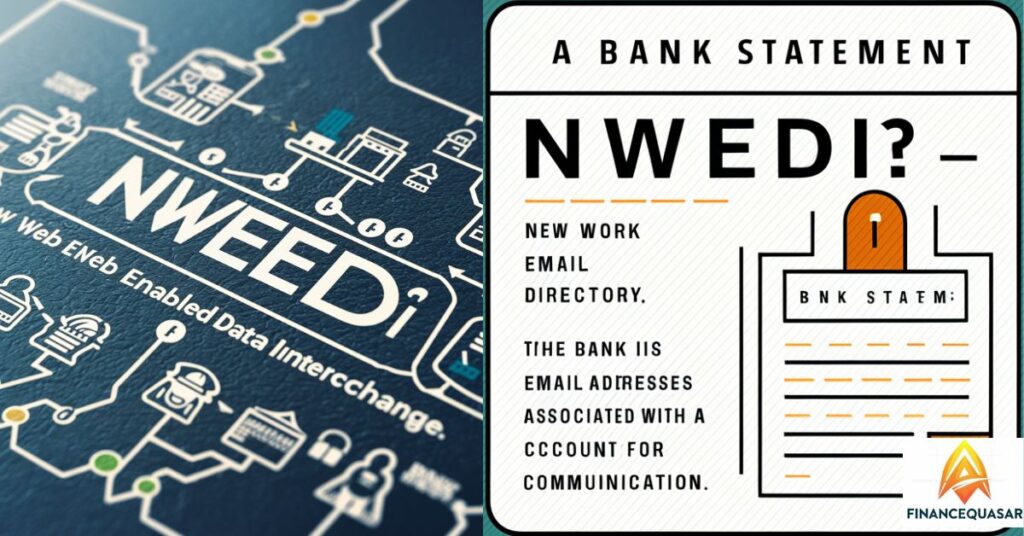If you’ve noticed the acronym NWEDI on your bank statement you might be wondering what it means. NWEDI stands for [Non-Working Day Excluded Interest]. This term typically appears on bank statements in relation to interest calculations.
NWEDI on a bank statement signifies Non-Working Day Excluded Interest, indicating interest calculations exclude weekends and holidays.
Ever noticed NWEDI on your bank statement Curious about its significance? Let’s uncover what NWEDI means and how it impacts your finances.
You can read this:[https://financequasar.com/what-is-lh-trading-charge/]
How Do NWEDI Charges Show Up on Your Bank Statement?

NWEDI charges typically appear on your bank statement as line items associated with specific transactions. Here’s how NWEDI charges might show up on your bank statement:
Transaction Description
You may see a description that includes NWEDI or “Non-Working Day Excluded Interest” alongside the details of the transaction. This description helps you identify the nature of the charge and its relationship to interest calculations excluding non-working days.
Amount
The bank statement will display the amount of the NWEDI charge associated with the transaction. This amount reflects any interest calculations that exclude non-working days, as indicated by NWEDI.
Date
NWEDI statements typically include the date of the transaction alongside the amount and description.
Transaction Code
In some cases, banks may use specific transaction codes or identifiers to categorize NWEDI charges separately from other types of fees or transactions on your statement.
It’s important to review your bank statement carefully to understand any NWEDI charges and their implications for your account. If you have any questions or concerns about NWEDI charges or any other transactions on your bank statement, don’t hesitate to contact your bank for clarification and assistance. They can provide you with detailed information about the charges and help address any inquiries you may have.
Understanding NWEDI Charges
First, ensure you understand what NWEDI charges entail. Understanding how these charges are applied will help you take appropriate actions to prevent them.
Review Account Terms and Conditions
Check your bank account’s terms and conditions to understand the specific circumstances under which NWEDI charges may apply. Familiarize yourself with any policies related to interest calculations, account maintenance, and fee structures.
Monitor Account Activity
Regularly monitor your bank account activity to stay informed about any NWEDI charges or other fees that may be incurred. Reviewing your bank statements and transaction history can help you identify any unexpected charges and take timely action.
Avoid Overdrawing Your Account
NWEDI charges may sometimes be associated with overdrafts or insufficient funds in your account. To prevent overdraft fees and associated NWEDI charges, ensure you maintain a sufficient balance in your account to cover your transactions.
Set Up Alerts
Many banks offer account alert services that notify you of low balances, unusual activity, or upcoming payments. Consider setting up alerts to receive notifications about potential NWEDI charges or other account-related matters.
Manage Your Finances Wisely
By staying organized and mindful of your financial situation, you can avoid unexpected charges and fees.
Contact Your Bank
If you have questions or concerns about NWEDI charges or need assistance in preventing them, don’t hesitate to contact your bank. They can provide guidance, explain the charges, and offer solutions to help you avoid future occurrences.
By taking proactive measures and staying informed about your account activity, you can effectively prevent NWEDI charges and maintain control over your finances.
What are NWEDI PAYMENTS Flex Charges on Your Bank Statement?

If you’ve come across NWEDI PAYMENTS Flex Charges on your bank statement, you might be curious about what it entails. Let me explain:
NWEDI PAYMENTS Flex Charges typically refer to a category of charges or fees related to flexible payment options offered by your bank or financial institution. Here’s a breakdown of what each component might represent:
PAYMENTS
This part of the statement likely refers to transactions or charges related to payments made through your account.
Flex Charges
Flex Charges suggests that these are fees or charges associated with flexible payment options provided by your bank. These could include fees for overdraft protection, expedited payments, or other services that offer flexibility in managing your finances. It’s essential to review these charges carefully to understand what they represent and ensure they align with your banking activities and expectations.
Discovering NWEDI EDI payments flex

Discovering NWEDI EDI payments flex on your bank statement may raise questions about the nature of these transactions. Here’s what you should do if you encounter NWEDI EDI payments flex:
Review Your Bank Statement
Carefully examine your bank statement to identify any NWEDI EDI payments flex transactions. Note the date, amount, and description of each transaction to gain a better understanding of their origin.
Contact Your Bank
If you’re unsure about the meaning or legitimacy of NWEDI EDI payments flex, contact your bank’s customer service. Explain that you’ve noticed these transactions on your statement and request clarification regarding their purpose and source.
Request Investigation
If you suspect that the NWEDI EDI payments flex transactions are unauthorized or fraudulent, request that your bank conduct an investigation. Provide any details or evidence you have to support your claim and ensure prompt resolution.
Consider Security Measures
As a precautionary measure, consider reviewing your account security settings and updating your passwords or PINs. Monitor your account activity closely for any suspicious transactions and report them to your bank immediately.
Follow Up Regularly
Stay engaged with your bank throughout the resolution process. Follow up regularly to check the status of the investigation into the NWEDI EDI payments flex transactions and ensure that any concerns are addressed promptly.
Take Preventive Measures
After resolving the issue, consider taking preventive measures to protect your account from future unauthorized transactions. This may include setting up account alerts, monitoring your credit report, and being cautious with sharing sensitive information.
NWEDI EDI payments flex vs. Traditional Forms of Payment through EDI
NWEDI EDI payments flex and traditional forms of payment through EDI represent different approaches to electronic funds transfer within the context of Electronic Data Interchange (EDI). Here’s a comparison between the two
Traditional Forms of Payment through EDI
Traditional forms of payment through EDI involve electronic transfers of funds and financial documents between trading partners using the EDI system.
What Is NWEDI EDI PYMNTS?

NWEDI
NWEDI EDI PYMNTS typically refers to a transaction involving Electronic Data Interchange (EDI) payments where NWEDI stands for Non-Working Day Excluded Interest. Here’s a breakdown of each component:
EDI
This abbreviation stands for Electronic Data Interchange, which is a method used by businesses to exchange documents and transactions electronically in a standardized format. In this context, EDI PYMNTS indicates that the payment transaction was conducted using EDI.
PYMNTS
This type of transaction is commonly used in business-to-business (B2B) transactions to facilitate efficient and automated payment processing between trading partners.
Implementation of NWEDI EDI payments
Here’s how the implementation of NWEDI EDI payments typically occurs:
System Integration
Businesses implement NWEDI EDI payments by integrating NWEDI calculations into their existing EDI systems or financial software.
Customization
Depending on the specific requirements of the business and its trading partners, customization may be necessary to tailor NWEDI EDI payment processes to meet unique needs. This could involve configuring software settings or developing custom scripts to accommodate NWEDI calculations within EDI transactions.
Training and Education
Staff members involved in processing NWEDI EDI payments receives training and education to understand the implementation process, including how NWEDI calculations affect interest accrual and payment processing. This ensures that personnel are equipped to handle NWEDI EDI transactions effectively.
Communication with Trading Partners
Businesses communicate with their trading partners to inform them of the implementation of NWEDI EDI payments and any changes or enhancements to payment processes.
Monitoring and Maintenance
Regular audits and reviews of NWEDI calculations help identify and address any issues or discrepancies promptly.
Continuous Improvement
Businesses strive for continuous improvement in NWEDI EDI payment processes by seeking feedback from stakeholders, monitoring performance metrics, and identifying opportunities for optimization. This iterative approach ensures that NWEDI EDI payments remain efficient and effective over time.This implementation enhances efficiency, accuracy, and alignment with business day conventions in financial transactions conducted through EDI.
What Are EDI Payments?
EDI payments refer to Electronic Data Interchange payments. Electronic Data Interchange (EDI) is a method used by businesses to exchange documents and information electronically in a standardized format.
Types of EDI Payments
There are several types of Electronic Data Interchange (EDI) payments commonly used by businesses for electronic transactions. Here’s an overview of the main types:
Electronic Funds Transfer (EFT)
EFT transactions are initiated by the payer and processed through the Automated Clearing House (ACH) network, which facilitates secure and efficient fund transfers.
Electronic Checks (E-Checks)
Electronic checks, or e-checks, are digital versions of traditional paper checks. They contain the same information as paper checks, including the payer’s bank account number, routing number, and payment amount.
Electronic Invoicing (E-Invoicing)
E-invoicing involves the electronic generation, delivery, and processing of invoices between trading partners. E-invoicing streamlines the invoicing process, reduces processing time, and minimizes errors associated with manual data entry.
Automated Clearing House (ACH) Payments
ACH payments enable electronic transfers of funds between bank accounts within the United States. Each type offers its own benefits in terms of convenience, efficiency, and security, contributing to streamlined business operations and improved cash flow management.
The Changing World of EDI Payment
The landscape of Electronic Data Interchange (EDI) payments is evolving rapidly, driven by technological advancements, changing business needs, and shifting market dynamics. Here’s a glimpse into the changing world of EDI payments:
Automation
EDI payments automate the exchange of financial documents and transactions between trading partners. This automation reduces the need for manual intervention, streamlines processes, and eliminates errors associated with manual data entry.
Cost Savings
By reducing manual processes, paperwork, and administrative overhead, EDI payments can lead to cost savings for businesses. This includes savings on labor costs, paper, printing, postage, and document storage.
Faster Processing
This accelerated processing time improves cash flow and liquidity management for businesses by reducing payment processing cycles.
Accuracy and Reliability
The standardized format of EDI transactions reduces the risk of errors and discrepancies often associated with manual data entry. This improves the accuracy and reliability of financial transactions, leading to fewer payment disputes and reconciliation issues.
Improved Visibility and Tracking
EDI payments provide greater visibility into the status of transactions, allowing businesses to track payments in real-time. This enhanced visibility helps businesses better manage cash flow, monitor transactional activity, and identify any potential issues or delays promptly.
Competitive Advantage
Adopting EDI payments can provide businesses with a competitive advantage by improving operational efficiency, reducing costs, and enhancing customer satisfaction through faster and more reliable payment processing.
Regular Business Transactions
The automated nature of EDI streamlines these processes, reducing manual errors and accelerating transaction times.
High Transaction Volumes
They automate repetitive tasks, allowing businesses to process large numbers of transactions quickly and accurately.
Supply Chain Management
EDI payments are ideal for managing transactions within supply chains. They facilitate seamless communication between suppliers, manufacturers, distributors, and retailers, enabling efficient inventory management, order fulfillment, and payment processing.
Trading Partner Requirements
Many large retailers, manufacturers, and government agencies require their suppliers to use EDI for transactions. If your trading partners mandate EDI, adopting it ensures compliance and maintains smooth business relationships.
Cost Reduction
If you’re looking to reduce operational costs associated with manual payment processing, EDI payments offer a cost-effective solution. They eliminate the need for paper-based documents, manual data entry, and postage, resulting in significant savings over time.
Faster Payment Processing
If your business relies on timely payments for cash flow management, EDI payments can expedite the process. They shorten payment cycles by eliminating delays caused by manual processing, enabling faster receipt of funds.
Improved Accuracy and Compliance
EDI payments ensure greater accuracy and compliance with regulatory requirements. The standardized format of EDI transactions reduces the risk of errors and ensures consistency in data exchange, enhancing compliance with industry standards and regulations.
Integration with ERP Systems
If your business uses enterprise resource planning (ERP) systems for financial management, EDI payments can seamlessly integrate with these systems.
Assess your business needs, transaction volume, and trading partner requirements to determine if EDI payments are the right solution for your organization.
Is an EDI Payment a Direct Deposit?
Direct Deposit
Direct deposit eliminates the need for paper checks and offers convenience, security, and faster access to funds for recipients.
File a Fraud Report
Provide details about the unauthorized charges and follow any instructions provided by authorities.
Monitor Account Activity
Continue monitoring your bank account activity closely after reporting unauthorized charges. Stay vigilant for any additional unauthorized transactions and promptly report them to your bank.
Protect Personal Information
Take steps to safeguard your personal and financial information to prevent future unauthorized charges.
Follow Up with Your Bank
Stay in communication with your bank throughout the resolution process.
FAQ’s
What does NWEDI mean on my bank statement?
NWEDI stands for Non-Working Day Excluded Interest.
What are NWEDI PAYMENTS Flex Charges on my bank statement?
NWEDI PAYMENTS Flex Charges refer to fees or charges related to flexible payment options offered by your bank.
What is NWEDI EDI PYMNTS?
NWEDI EDI PYMNTS typically refers to a transaction involving Electronic Data Interchange (EDI) payments, with NWEDI indicating that interest calculations exclude non-working days.
What are EDI payments?
EDI payments refer to Electronic Data Interchange payments, which involve the electronic transfer of funds and financial information between businesses in a standardized format.
What is the difference between manual payments and EDI payments?
Manual payments involve traditional paper-based methods of transferring funds and typically require manual data entry, resulting in slower processing times and a higher risk of errors.
These FAQs cover some common questions about NWEDI, NWEDI PAYMENTS Flex Charges, NWEDI EDI PYMNTS, EDI payments, and the difference between manual payments and EDI payments.
Conclusion
NWEDI PAYMENTS Flex charges on a bank statement represent transactions that involve Non-Working Day Excluded Interest (NWEDI) with flexible payment arrangements. These charges reflect the utilization of electronic payment methods tailored to specific financial agreements, ensuring accurate interest calculations aligned with business days.

I am constantly seeking new challenges and opportunities to make a positive impact through my work. With my passion for innovation and drive for success, i continues to push the boundaries of what is possible in the ever-evolving world of technology.
In addition to my technical skills, I am known for my strong communication and leadership abilities. I thrives in collaborative environments, where i can leverage my expertise to drive projects forward and inspire teams to achieve their goals.







